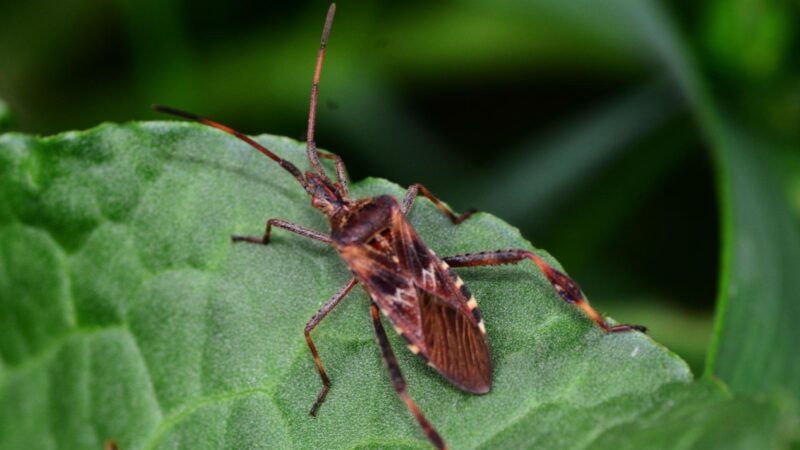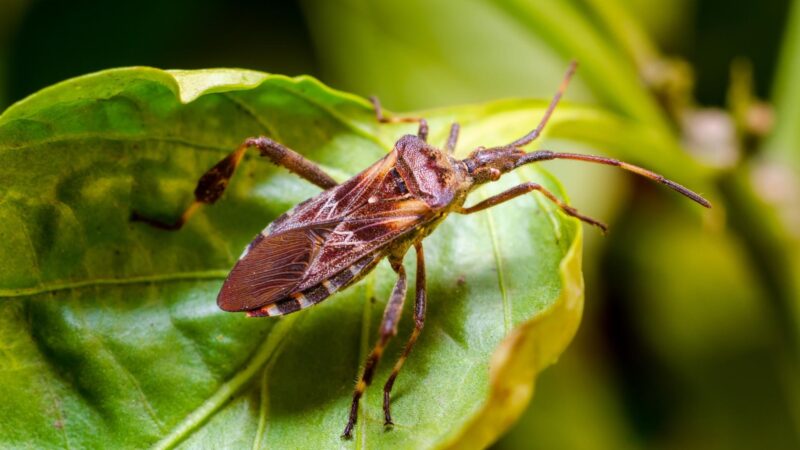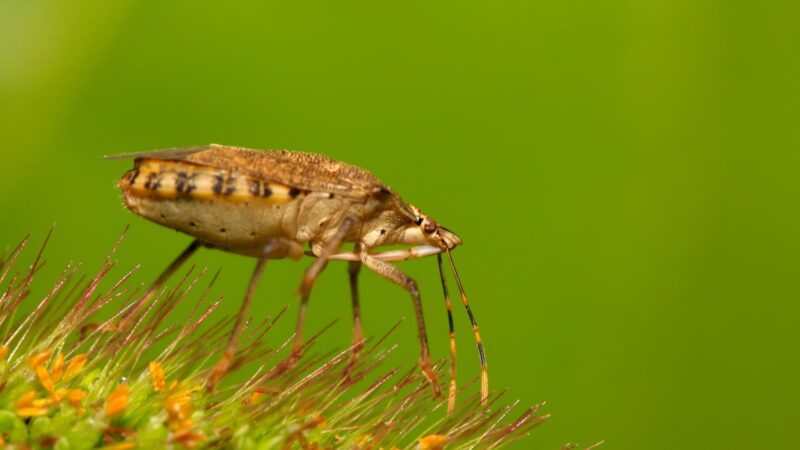You may see some insects inside your house, even on a sunny winter day. These tiny creatures are unwanted, and their smell is annoying.
To get rid of them, it’s best to identify them to apply the proper solution, or else you’ll get frustrated if you misidentify them.
What is in your house: a stink bug or a western conifer seed bug? You can either find a stink bug or a western conifer seed bug in your house, wall, or windowsill. Both of these insects seek overwintering sites, so either of them gets into your house for warmth. But the western conifer seed bug takes most of the blame.
You can’t blame some individuals as the western conifer seed bug looks similar to many insects, including the brown stink bug. Some entomologists even misidentified it as a left-footed pine seed bug.
You’ll likely have this bug in your house if there are evergreens with cones nearby. To avoid making mistakes between these two insects, read on.
Table of Contents
What Is a Stink Bug?

The brown stink bug that looks like the western conifer seed bug is originally from Eastern Asia, and it found its way to the US. It can even be found in South America and Europe.
It’s considered a pest, as it destroys vegetables and fruit trees. Stink bugs can cause damages worth millions of dollars. Both government and private sectors spend time and money on the control of this pest.
Just as its name suggests, this bug releases a stinky, sharp, acidic smell. It’s their defense mechanism against predators. This unpleasant smell came from the special glands located on their thorax.
It’s released on this bug’s exoskeleton termed as evapatorium. Due to the evapatorium’s shape and texture, this stink odor doesn’t stay for too long.
- Scientific Name: Pentatomidae
- Appearance: Brown, with light-colored bands on antennae, light and dark banding on the abdomen’s rear, nymphs or young ones have red eyes and legs with white bands, has 6 legs.
- Size: 1.5 cm long
- Lifespan: 6 to 8 months
- Habitat: Gardens, orchards, and farms
- Diet: Crops like soybeans, flowers, leaves, fruits, and insects like caterpillars
How Do You Get Rid of Stink Bugs?
Stink bugs don’t bite humans, but the thought of insects inside your house is not a good idea. You don’t want to sniff its bad odor either. You can do these simple ways in getting rid of stink bugs:
- If you’re not too sensitive, you can just handpick them, and you can put on gloves before doing it.
- You can use a vacuum to catch stink bugs since they’re slow-moving insects. Discard the bag right away.
- You can also make a trap that requires a pan, foil, dish soap, and water. Virginia Tech Department of Entomology was created based on the fact that light can attract stink bugs. It’s more effective than the traps that you can buy.
- Wrap the foil around the pan and put water and dish soap in it. Place a light over the pan and attract stink bugs so they’ll drown.
How to Get Rid of Stink Bug Smell?
You don’t need to worry or put the effort into getting rid of the stink bug smell as it’s temporary, and it will go away on its own.
What Is a Western Conifer Seed Bug?

A western conifer seed bug doesn’t bite or sting. Still, its presence is not welcomed by humans. Thus, complaints from houses, laboratories, and offices are common, especially in spring and fall.
These are the seasons that this bug is rampant. Although they don’t damage anything inside a house or building, a lot of bugs in a certain place are not likable.
Just like stink bugs, western conifer seed bugs are also considered pests because they are coreid bugs that consume conifers that have great importance to the economy.
They like the gooey goodness within conifer seeds. Moreover, they also like Scotch pine, white spruce, Douglas-fir, red, and white pines.
At a single glance, it’s easy to misidentify a western conifer seed bug as a stink bug. But if you look closely at its lower hind legs, you’ll find a tiny leaf-like part. Stink bugs and other insects don’t have it. They’ll only have straight, cylindrical legs.
- Scientific Name: Leptoglossus occidentalis
- Appearance: Brownish back, white and black checkers on the back’s lower portion, abdomen side is yellow or light orange, nymphs are orange and become reddish after molting a few times.
- Size: 1.9 cm (3/4”)
- Lifespan: Almost a year
- Habitat: Pine trees
- Diet: Soft tissues and needles of cone scales
How Do You Get Rid of Western Conifer Seed Bugs?
Swatting and vacuuming can get rid of western conifer seed bugs. Since it’s a slow-moving insect, you can just handpick it.
What Do Stink Bugs and Western Conifer Seed Bugs Do?

It’s easy to think that stink bugs and western conifer seed bugs are the same because of some things that they have in common aside from having the same appearance.
They both release gas when they feel threatened. Stink bugs give off the stinky acidic smell, while the western conifer seed bugs release a piney odor.
Both of them also look for overwintering sites. They’re considered pests too. Stinky bugs destroy crops, tree fruits, and vegetables.
They leave discoloration and chlorotic spots or necrosis on the produce. Their activity results in malformed fruit which becomes unmarketable.
In the case of western conifer seed bugs, their consumption of the sap of green twigs and cones doesn’t affect a healthy tree. However, they still cause damage as they inhibit the seeds on the cones to develop.
On the brighter side, these bugs don’t harm humans. Even though they enter your house, they won’t damage anything.
The number of these bugs that enter your house is sometimes surprising and overwhelming. No one would like to have a lot of insects inside the house as it will appear like there’s an infestation.
What Attracts Stink Bugs and Western Conifer Seed Bugs to Your House?
When the temperature is above freezing in spring and fall, stink bugs and western conifer seed bugs are attracted to your house. This simply shows that they need warmth.
Since homes are heated, these bugs would take advantage of it so they can be in an active state. But they still stay in houses without a heating system, but they’re just dormant as they enjoy the coziness.
Are Stink Bugs and Western Conifer Seed Bugs Invasive?

They’re both invasive. Stink bugs are native to China, Japan, and Korea. But they reached Pennsylvania, and they’re now prevalent in the eastern and western parts of the United States.
The increase in their population leads to damage to fruits, vegetables, rice, weeds, ornamental plants, and various crops. The areas that are not occupied by these insects should watch out for their infestation by regularly checking plants.
Western conifer seed bugs invade homes with a lot of pine trees nearby. It’s a common situation all over Chile. It even caused people to panic because of identification issues.
They think that these insects are kissing bugs, so they worry about Chagas disease, which is irrelevant. It also leads to overusing of pesticides in urban places. This action is not good as it can harm both animals and humans when used incorrectly.
How Do You Know if You Have an Infestation?
You’ll know that there’s an infestation if you see many of them inside your house. As for the stinky bugs that dwell outdoors, you’ll see scarred fruits and sunken or deformed pods of crops like corn.
They create a spongy area, scar, and internal tissue damage on fruits and vegetables.
The damage that western conifer seed bugs make is hard to notice since it doesn’t affect the health of the trees.
But you might misidentify it as other bugs. You can confirm by checking if there’s like a tiny leaf on the lower hind legs of the bug.
What Time of the Year Stink Bugs and Western Conifer Seed Bugs Are Active?

They’re active in spring. The damages caused by stink bugs on plants emerge in this season. Moreover, you’ll likely see western conifer seed bugs inhabit the trees and feed on year-old cones and male flowers in the same period.
How Can Stink Bugs and Western Conifer Seed Bugs Be Controlled?
While the method of eliminating them inside your house can be done through vacuuming, the approach is different when they’re outdoors.
The use of pesticides to control these bugs can be harmful as some helpful insects like pollinators can also die. So, border sprays are applied on areas with high pest densities as the pesticides don’t reach the nearby forested areas.
Summary
The search for stink bugs and western conifer seed bugs for overwintering sites can make you misidentify them easily. They have similarities in color and appearance, and they’re both active in spring and can later get into your house.
Aside from being annoyed by their presence, they don’t harm humans at all, so you don’t have to worry. Just discard them outdoors.